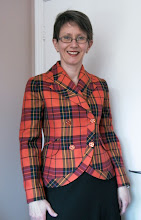 At right is the inspiration, the Tide Loop Top pattern by Other Loops.
At right is the inspiration, the Tide Loop Top pattern by Other Loops. I completely redesigned the shape of the top. The original has a deep scoop at the back and is quite high in the front. Mine has a reasonable scoop at front and is quite high in the back.
I used the pattern (sort of), knitting size XL to get a circumference approximating size S. But above the armholes, I made up the shaping as well as the patterning.
My edges are also different from the pattern. It called for a sewn hem and I did ribbing. It called for the neck and armhole openings to be finished with 3 rows of stockinette that would roll towards the RS. I finished these edges with iCord, knitted by machine.
Knitting it took a while (read on to understand why) but I am super satisfied with this project!
What was the technical challenge?
The defining characteristic of the fabric of the Tide Loop Top is the uneven horizontal stripes of reverse knitting, creating irregular textured stripes or ripples. In this top, most of the stitches have their purl side facing out, but the recessed stripes are the opposite (knit side facing). This apparently simple texture is quite hard to create on a knitting machine. Purls have to become knits, but not an entire row at a time. And the patterning is quite irregular across the rows as well as between the rows of recessed stripes. The in and out texture combined with the irregularity means that this is the hardest type of fabric to knit on a domestic knitting machine.*
The U100E is a tool that helps make this type of texture. It is a transfer carriage. All it does is move stitches from needles on one bed of the machine to needles on the opposite bed. Once moved, the (formerly) "knit" stitch can be worked as a "purl" or vice versa.
It works with Passap knitting machines. It didn't come with my machine, and I no longer remember where/how I purchased it or, for that matter, how long it had sat on a shelf. I had bought it, but I had never used it.
In more detail (possibly TLDR, you can skip to the next section if you want)
The Passap is a "true" double bed knitting machine, which means it has two functionally identical beds of needles that sit at a fixed angle. Each bed is equipped with almost 200 latch hook needles.
The beds are oriented as in this diagram.
Because the hooks of the needles on one bed face in the opposite direction from those on the other, stitches made on one bed are the physical reverse of the stitches made on the other. One side makes the knits and the other side makes the purls.
On a double bed machine, you can use needles on two beds (as in the diagram) to knit a tube - first the machine knits all the needles on one bed and then it knits all the needles on the other bed, and then it repeats. This is the same as knitting in the round in hand knitting.
Or you can use both beds at the same time to make a ribbed fabric. This involves knitting a few stitches on one bed and then a few on the other and repeating so that the yarn zigs and zags between the two beds along a single row. You can do the same thing with hand knitting needles. There will be some knits, and then some purls, and some more knits and purls along the knitted piece.
When knitting by hand, it's quite easy to make fabric that isn't ribbing, but has a texture created by both knits and purls in a single row. You can work either a knit or a purl into any stitch along the needle. You can do this either in the round, or when turning the knitting between rows. Garter stitch is made with only the knit stitch, but when you turn the knitting and work knitted stitches on the back side of the fabric, you are always working a knit stitch into a purl stitch (the back of a knit stitch).
Making some knit/some purl fabric (other than ribbing, which lines the knits and purls up vertically) is not at all straightforward on a machine. You need a mechanism for transforming a stitch (physically turning it around so what was front is back, or vice versa). This can be done completely manually - unravel the knit stitches that you want to be purls, hook them up backwards and rehang. Or you can use a double eye transfer tool to switch stitches, one by one, from one bed to the other.
If you want to knit garter stitch (knit rows and purl rows alternate) you can use a garter bar to flip the fabric, physically, before knitting every single row. Other, more complex types of patterning can be done automatically with a garter carriage (only Brother machines). Or, if you have a Passap, you can use the U100E to transfer all the stitches in a row to the opposite bed, or just some of them.
For all readers


.jpg)



Very cool project and congratulations on successfully learning to use the transfer carriage!
ReplyDelete